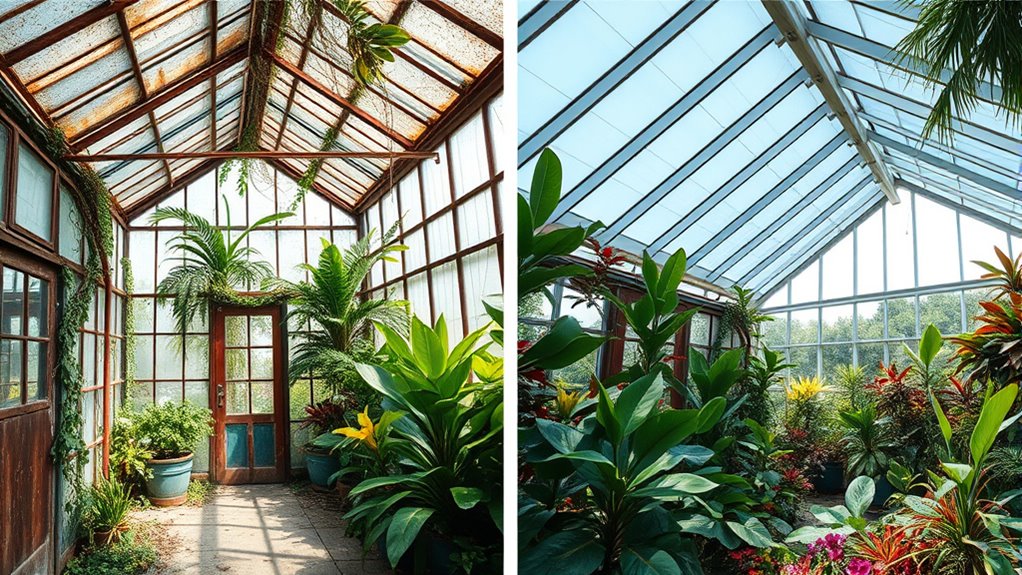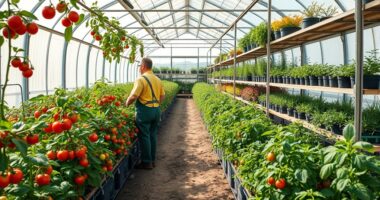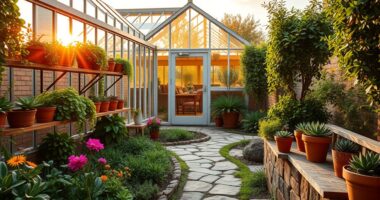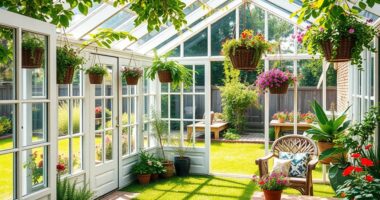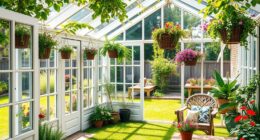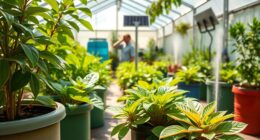Transforming a simple greenhouse into a thriving, sustainable ecosystem showcases impressive growth and innovation. Through strategic propagation, you can start plants from cuttings and seeds, boosting diversity and strength. Eco-friendly pest control methods like beneficial insects and organic sprays keep pests in check naturally. By combining these practices, your greenhouse becomes more resilient and self-sufficient. If you continue exploring, you’ll discover inspiring stories of how small changes can lead to remarkable transformations.
Key Takeaways
- Propagation techniques like cuttings and seeds transform a basic greenhouse into a vibrant, thriving ecosystem.
- Implementing eco-friendly pest control methods enhances plant health and promotes sustainable growth.
- Combining propagation and pest management creates a resilient, self-sufficient greenhouse environment.
- Small strategic changes lead to significant improvements in plant diversity, strength, and productivity.
- The transformation showcases how dedication and innovative practices turn a simple space into a sustainable garden hub.
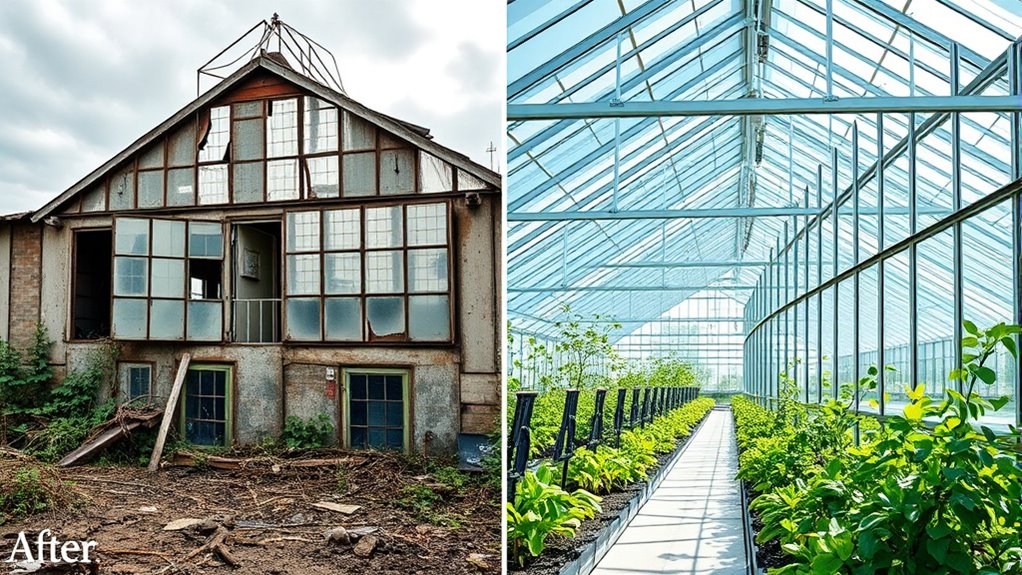
Have you ever wondered how a simple greenhouse can evolve into a thriving hub of innovation and sustainability? It all begins with understanding the power of plant propagation. When you start experimenting with different propagation techniques, such as cuttings, layering, or seed starting, you access the potential to grow a diverse range of plants efficiently. Instead of relying solely on buying mature plants, you learn to propagate your own, which saves money and accelerates your gardening projects. Over time, this practice transforms your greenhouse from a basic shelter into a dynamic space where new plants flourish. As you refine your propagation methods, you notice how healthier, stronger plants develop quicker, setting the stage for more ambitious gardening goals.
Starting with plant propagation transforms your greenhouse into a thriving, efficient, and sustainable garden hub.
Alongside plant propagation, pest control becomes a vital aspect of transforming your greenhouse into a sustainable haven. Initially, pests can seem like an unavoidable nuisance, threatening your plants’ health and growth. But with a proactive approach, you implement integrated pest management strategies. You might introduce beneficial insects like ladybugs or lacewings to naturally control aphids or use organic sprays to keep harmful pests at bay. These methods don’t just protect your plants; they also enhance the overall health of your greenhouse ecosystem. As you develop a pest control routine that minimizes chemical use, your greenhouse shifts from a chemically dependent space to one rooted in eco-friendly practices. This shift not only improves plant health but also aligns with sustainable living principles, making your greenhouse a model for eco-conscious gardening.
The evolution continues as you combine effective plant propagation with strategic pest control. You start to see your greenhouse develop into a resilient environment where plants thrive naturally. You’re no longer just growing plants—you’re creating a balanced system where pests are kept in check, and new plants are propagated efficiently. This synergy allows for higher yields, healthier plants, and a more sustainable operation overall. Over time, the space becomes a thriving hub of innovation, where you experiment with different plant varieties and sustainable practices, continually pushing the boundaries of what a greenhouse can achieve.
In this evolution, your greenhouse becomes more than just a shelter for plants; it becomes a reflection of your dedication to sustainability and growth. The journey from a basic structure to a thriving, self-sufficient ecosystem shows how small changes in plant propagation techniques and pest control methods can make a big difference. It’s a proof of how thoughtful adjustments and consistent effort can turn a humble greenhouse into an inspiring space of innovation. And as you look back on your progress, you’ll realize that the real transformation happened within your approach, making your greenhouse a true success story.
Frequently Asked Questions
What Materials Are Best for Greenhouse Construction?
When choosing materials for your greenhouse, you want options that optimize light and durability. Polycarbonate panels are excellent because they’re strong and provide good insulation, while glass offers maximum sunlight for plant growth. Consider your plant selection and ventilation systems too; proper airflow helps maintain temperature and humidity. Combining sturdy materials with effective ventilation creates an ideal environment, ensuring your plants thrive and your greenhouse remains functional year-round.
How Long Does a Typical Greenhouse Renovation Take?
A typical greenhouse renovation usually takes a few weeks to a couple of months, depending on the scope. You’ll want to plan for sustainable practices, like eco-friendly materials and energy-efficient systems, which might extend the timeline slightly. During renovation, focus on pest management to protect your plants. Proper planning guarantees minimal disruption, so you can enjoy your transformed greenhouse sooner while maintaining sustainable growth and healthy crops.
What Are Common Challenges in Greenhouse Transformations?
Think of transforming your greenhouse as taming a wild beast—challenges are inevitable. You’ll face issues like maintaining proper climate control, which is essential for healthy plants, and pest management to prevent infestations. These hurdles can feel overwhelming, but with careful planning and consistent effort, you’ll turn your space into a thriving oasis. Embracing these challenges helps you grow stronger, making your greenhouse transformation truly rewarding.
How Much Does a Greenhouse Upgrade Usually Cost?
When you’re considering a greenhouse upgrade, understanding the cost analysis is essential. Typically, upgrades range from a few thousand dollars for basic improvements to tens of thousands for large, high-tech structures. You should plan your budget carefully, including materials, labor, and potential upgrades. By doing so, you guarantee your investment aligns with your needs, helping you make informed decisions and maximize the benefits of your greenhouse transformation.
Can DIY Methods Be Effective for Greenhouse Improvements?
Can DIY methods be effective for greenhouse improvements? Absolutely! DIY success depends on your skills, planning, and patience. With budget gardening in mind, DIY upgrades can boost your greenhouse’s efficiency, durability, and comfort without breaking the bank. You take control of the process, customize your space, and learn valuable skills. Whether you’re adding insulation, installing vents, or painting, your hands-on approach can transform your greenhouse efficiently and affordably.
Conclusion
Seeing these incredible greenhouse transformations proves you don’t need a big budget to create a beautiful, functional space. With a little creativity and effort, you can turn an ordinary structure into your dream garden haven. Don’t let doubts hold you back—every project starts with a single step. Imagine the joy of stepping into your own lush, thriving greenhouse. So, why wait? Your stunning garden transformation is just a decision away!
